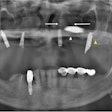Radiographic periodontic ligament (PDL) widening may be a more sensitive indicator than serum C-terminal telopeptide (CTX) testing in predicting risk of bisphosphonate-related osteonecrosis of the jaw (BRONJ), according to a study in Oral Surgery, Oral Medicine, Oral Pathology, Oral Radiology, and Endodontology (October 2010, Vol. 110:4, pp. 509-516).
Researchers from New York University College of Dentistry conducted a retrospective review of radiographic and/or serum CTX data for 68 patients with a history of bisphosphonate therapy. Postoperative healing was assessed for 26 patients with reduced serum CTX levels (< 150 pg/mL) who either underwent dental extraction or treatment for BRONJ. Preoperative radiographs were evaluated for 55 patients who either healed normally or developed BRONJ after dental extraction.
Previous studies have suggested that reduced serum CTX can determine the degree of osteoclast suppression and may predict the development of BRONJ after dentoalveolar surgery, the researchers noted. Although many radiographic appearances are associated with BRONJ, few studies describe changes preceding dentoalveolar surgery.
All 26 patients who had serum CTX levels of less than 150 pg/mL healed successfully after dentoalveolar surgery or after treatment for BRONJ. Among the 55 patients who underwent radiographic evaluation, 24 patients with BRONJ exhibited PDL widening associated with extracted teeth, whereas only three patients who healed normally demonstrated PDL widening.
These findings suggest that current guidelines that recommend minimal surgical intervention may need to be revised to include alternative strategies for the elimination or management of PDL widening, the researchers noted.
Copyright © 2010 DrBicuspid.com



















